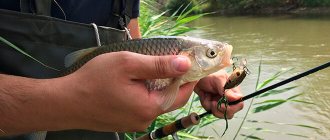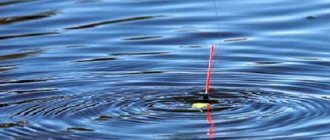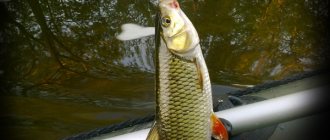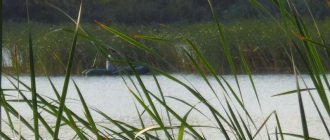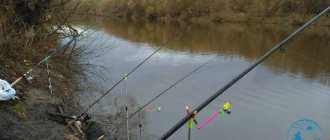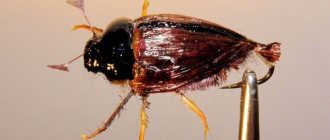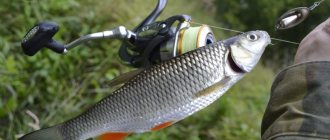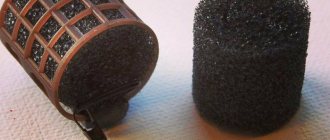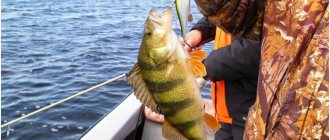Bottom tackle or feeder, as it is now called, is intended for catching fish from the bottom. The advantage of this tackle is that you can cast it, install a bite alarm and wait for the desired trophy to bite. At this time, you can go about your business or just relax, enjoying the beauty of nature. This is exactly the case when business is combined with pleasure.
Chub habitat
As a rule, chub are found in small and medium-sized rivers. He prefers clean, cool water. At the same time, we can note the most promising places for chub on the river:
- in the area of whirlpools;
- in areas of fast current;
- at the boundaries of slow and fast currents;
- on cliffs;
- in the area of overhanging trees;
- in places where you can visually observe a chub chasing a fry.
All of the above areas of the water area are interesting for this fish, and it tries to stay in these areas.
Where to look for chub?
Perhaps the main conclusion to which this year’s season has led is that the chub can stand not only where we are used to seeing it.
Recently I have noticed the activity of chubs in sections of rivers with slow flows, and even in oxbow lakes. And this fundamentally does not correspond to my traditional ideas. Therefore, I will expand the circle of search for the “broad-minded”, and significantly. It follows: there are much more typical habitats for the chub and they are more diverse than we often think.
Naturally, I am not going to exclude from the list of promising traditional places that worked well in previous seasons: rifts and pits, places near bridges and other hydraulic structures that influence the flow of water.
But I (as a fairly ambitious fisherman) am interested in decent specimens. Yes, they are not easy to find. It is a great success to visually notice an individual over a kilo, almost fantastic. Reaching such a weight, chubs become truly invisible.
But still, large chub are always present in places where small ones accumulate. At least I have not encountered the opposite phenomenon.
Chub bait
The chub is an omnivorous fish and, under certain conditions, will not refuse any bait. These can be attachments of both animal and plant origin. Therefore, the list of baits can be large, since there are a lot of them. At the same time, the main, most effective ones can be noted:
- worms of various origins;
- maggot;
- little frogs;
- beetles or dragonfly larva;
- corn;
- peas;
- bread crust;
- live bait;
- insects (grasshoppers, moths, etc.)
Naturally, among them there may be the most beloved ones. This can be easily found out if you throw several donks with different baits. At the same time, it should be remembered that at different times of the year, your favorite bait may be different. Another factor worth noting is the impossibility of providing fishing with the same baits throughout the year. Therefore, the best option is to use seasonal baits. As a rule, when one or another living creature appears, the chub switches to the appropriate diet. For example, when the mayfly emerges, many fish begin to feed on the mayfly. This indicates that mayfly will be the best bait at this time.
Although this does not mean that you do not need to have backup options. Therefore, when going fishing, you should take with you several promising baits of both plant and animal origin.
Briefly about bait
- Frog is a working bait for large chub. Despite the fact that in some reservoirs the chub is reluctant to bite on this bait, the desired trophies will be caught quite often.
- Larvae. When catching chub, it is possible to use various larvae, such as the larva of the cockchafer, the larva of the bark beetle, the larva of a fly (maggot), etc. Unfortunately, the use of these larvae strongly attracts smaller fish.
- Dragonfly larva . In spring and early summer it is the best bait. For the fishing period from April to July, the best bait cannot be found.
- Peas and corn . These nozzles are capable of immediately “cutting off” small things. Good results can be obtained by using canned peas and corn, but in terms of catchability they are inferior to natural grains.
- Insects . Chub are not bad at catching on grasshoppers and dragonflies. Moreover, it’s hard to imagine summer fishing without baits such as a grasshopper or a fly.
- Bug. This refers to the cockchafer. As a rule, you can catch large chub with it.
To make the cockchafer more attractive, its wings should be torn off before attaching it to the hook.
Bait
Lamprey larva
is the best bait that fishermen have been using to catch chub for many years.
Some recommend using a crawler
, but the effectiveness of this bait is somewhat lower than the larvae.
Lamprey can be found in the muddy bottoms along the shore.
When casting again, the crawler will have to be changed, but the lamprey larva has greater vitality and will not have to be changed. Chicken liver
It is also a desired prey for chub, which is why many fishermen highlight it among other baits.
It has been noticed that a school of chub follows a clear hierarchy: first, small fish approach the feeding area, and large individuals swim to the food only after exploration by small fish. So catching chub on a donk can bring a fairly large trophy, you just need to wait for that very moment.
Chub fishing time
From mid-April until the beginning of winter, chub can be caught without any problems. It is most active in the summer months (June, July, August) . During the daytime, he tries to stay closer to the surface of the water, and in the evening, he goes deeper. At night, it is possible to catch trophy chub using bottom tackle.
In the spring and autumn periods, this fish mainly sticks to the bottom layers. Therefore, during these periods he is more likely to fall for bottom fishing rods.
In other words, chub can be caught on donkeys from early spring until late autumn.
Tackle
The equipment in the situation under consideration also has its own characteristics. There are quite a lot of varieties of gear. They, in turn, are divided into active and passive. The latter variety includes hooks, cords, releases, vents, as well as donks with rubber shock absorbers. It is worth keeping in mind that the so-called rubber band does not work in the current.
When used correctly, it is possible to assemble the device directly on the river. The condition is the presence of sinkers, fishing line and hook. Using videos from the Internet, you can learn how to make a donka with your own hands. This is a fairly functional and compact device. In September or any other month it will not be interesting enough to fish using the specified device.
Active gear is presented:
- Feeder. Such a device can be purchased at a special store.
- Donka may have a fishing rod.
- There are also half bottoms. It is represented by a fly or Bolognese fishing rod, on which the float is shifted to the tip.
To catch said fish, you will need to use a powerful device. The length of the device should vary from 1.5 to 2.5 meters. When fishing, spinning rods made of duralumin and telescopes made in China are used.
For moderate flows, feeders classified as heavy class are used. The maximum length is then 3.3 meters. Donka can be presented in the form of a spinning rod. In this case, the coil must be powerful and reliable. The volume for the spool is set to at least three thousand sizes. To ensure that the rod does not fall from the stand, the mechanism must be correctly configured to avoid unwinding in the stream.
Chub fishermen most often use a monk. Experts say that high information content is not needed when catching such fish, so there is no need to use a fence. Due to the shock-absorbing properties of monofilament, it will allow you to throw heavy loads without any worries.
Experts point out that the optimal size is considered to be from 0.28 to 0.35 mm. It is not recommended to use smaller monofilament threads due to the risk of snagging. In turn, a thick thread, due to its windage, leads to the displacement of even a load with a mass of 200 grams.
When fishing for chub, hooks assigned to numbers from 8 to 12 are used. These numbers are related to Russian numerology. This fish can easily swallow a hook number 10. For this reason, they say that when choosing gear you should pay attention to the size of the bait, regardless of the size of the fish itself.
Preference should be given to hooks equipped with a long shank. They allow a person to set bait that has volume. It will be easier for the fisherman to hook the fish himself using such a device.
It is worth paying special attention to the fact that the species of fish in question has quite powerful teeth. Therefore, it is not recommended to remove the hooks from the throat with your hands. Otherwise, the fisherman risks injury.
To tie the leash, a fishing line is used, which consists of fluorocarbon. Experts point out that it is best to use a leash whose diameter is from 02 to 0.25 mm. The length of such a device should vary from 40 to 60 cm. If some types of attachments are used, then a leash with a length of 80 cm can be used.
Requirements are established regarding the sinker so that it matches the bottom topography. If we talk about the bottom, where there are pebbles and sand, then you need to use a flat weight that looks like a spoon. This is due to the fact that such devices provide better adhesion to the bottom coating.
If areas of the bottom have snags or stones, then olive-shaped weights are used to prevent them from getting caught. The figure can also be like a cylinder.
A few tips on how to catch chub on a donk or feeder
Any type of fishing has its own, although not big, secrets. Naturally, every angler, sooner or later, through his own mistakes, will reach the level when all the nuances of such fishing are known. In order not to repeat the mistakes of others, it makes sense to dwell on a few useful tips that can help in mastering fishing with bottom gear or feeder, as they are called today.
Since the chub prefers to stay in areas with fast currents, it is necessary to fish in such conditions. When casting gear, the current carries the bait and can entangle it in thickets of aquatic vegetation. To prevent this from happening, you should look for places where you can cast not across the current, but along it. In this case, the bait with the feeder will not be able to move under the influence of the current. In addition, it is advisable to use only one tackle.
If there are no bites, you should not linger in one place. It is quite possible that there are no chub in this place, since it does not attract it for some reason. To search for chub anchorages, you need to cast several bottom fishing rods. If there are no bites, then this is a signal that the place will have to be changed.
If there are no bites, then it makes sense to use another technique: take and pull the tackle about 1 meter. Sometimes this approach brings results. This is due to the nature of the bottom topography and the presence of foreign objects at the bottom. It’s just that the bait can fall into these piles and the fish don’t notice it. As soon as the bait comes off the bottom, bites are possible at that moment.
Like any other fish, the chub does not really like noise on the shore. Therefore, when catching it, you should remain quiet and try not to be on the shore at full height. It is not necessary to stand or sit near bottom gear. The tackle is thrown, the bell is hung, after which you can leave the fishing rod and move as far away as possible. In case of a bite, the alarm will notify the fisherman. As a rule, fish hook themselves on bottom gear, so there is no need for hooking.
Other gear is also suitable for catching chub. In summer, chub are actively caught using artificial baits, such as flies, wasps, grasshoppers, dragonflies, etc. Naturally, for this you will have to take and master completely different gear, such as “fly fishing” or “bombard”. Unfortunately, this is gear that requires certain handling skills. Despite this, they are no less catchy than bottom fish. The advantage of using such baits is that you can catch more than one individual with one bait, such as a “fly”. At the same time, there is no need to search for natural baits such as larvae, bugs, insects, etc.
Fishing process
As mentioned above, to successfully catch chub on a donk, you need to constantly move. It is impossible to say exactly where the chub will be found today. Therefore, we methodically fish all promising areas. If bait is used for such fishing, it is with an emphasis on aromatics and animal components. In summer, you can use boiled peas or millet, and add chopped worms, leeches and chicken liver to them.
In cold water, you can feed it with broken ragul mixed with soil and flavored with worm or bloodworm odors. Some anglers mistakenly believe that they know exactly where to catch chub. They waste precious time fishing one point. And only after sitting in one place for an hour or two do they realize that they need to move.
In order not to rely on chance, it is better to check each point using different baits. For example, we attached a liver to a hook, didn’t get any bites, and tried to catch a beetle or dragonfly larva in a hole. There is no result, after 20 minutes we throw it at the exit from the pit. We catch with a bunch of worms. If in this case there are no bites, we move downstream and fish on the rifts, near overhanging trees, etc.
It is very important to know the structure and topography of the bottom. We knock on the bottom and watch how the nod of the rod bends. It's better to use a fence. In this case, even when fishing on a rigid rod, it will be clear that the bottom is shell-like, rocky or muddy. To do this, it is advisable to use the jig method by tapping the bottom with a weight. The weight knocks on the shell and stone so that the quivertype very often sways sharply. The load moves through the silt as if it is sliding. Visually it is quite easy to identify promising places. Areas with reverse currents, rifts and where the current intensifies are clearly visible. We focus on such places and fish in them.
When the chub takes the bait, we hook it, but don’t pull it against the current, but give it a little freedom, let it resist a little. It is very pleasant to fish for a chub, feeling the violent jerks and stubborn resistance. A well-functioning clutch will release the required amount of line, and the fish can be caught in a more convenient area. It is enough to go downstream and start fishing in a place where the bank is flatter. In such areas, you can pull a chub ashore without a landing net.
You can also use this technique when you drag the weight a little along the bottom and twitch it with a nod. A chub can take such a moving bait without delay. You can use a beetle, a bunch of worms, or a dragonfly larva as bait. We fish this way for 20-30 minutes and change the place. A large number of splashes from the weight does not help attract chub. It is important to change attachments as you go. It often happens that a chub completely refuses to take a worm or a leech, but very willingly takes a cockchafer. You can even offer him an artificial cockchafer. When a chub is hungry, it takes the bait without trying it.
Let’s talk separately about catching chub using chicken liver. The chub catches it best in March-April and at night in the summer. For such fishing, choose places where the current intensifies. As a rule, the banks in these areas are steep. Fishing tactics are as follows. We place the liver on a medium-sized double or a long-shanked hook. The equipment itself is sliding. It looks like this:
The sinker is clamped on both sides with rubber stoppers. It is better to use two stoppers on each side so that they move tightly along the line. The weight of the sinker can be from 30 to 70 grams, depending on the strength of the current. It is better to use a flat sliding sinker that lies well on the bottom. The length of the leash in this case is 70 cm. This is the optimal length for such fishing. The result is a super sensitive rig with a sliding weight. This is especially important when fishing in currents. We throw the bait with the liver to the place of the main current. The rod can be held in your hand or placed on a stand at an angle of 60-70 degrees to the shore. But you don’t need to move away from it, since the chub bite is very fierce and you can not only miss it, but then catch a donkey floating along the river.
Chicken liver is quite soft and will not stay on the hook for long. The calculation is made not only on the taste characteristics of this attachment, but also on its aroma. In the water there is a trail of thin blood streaks from it. These stripes are especially noticeable when fishing in cold water.
We fish for about 20 minutes in one place, then we move 20-30 meters downstream and again use the same tactics: we cast to the fastest places and wait for a bite. This way we manage to catch 6-7 places in one fishing trip. In at least a few of them you can count on catching good specimens. At night they are caught in the coastal zone at the exits of their pits, where the bottom is hard. There is no need to change places; they fish in one place with several rods.
